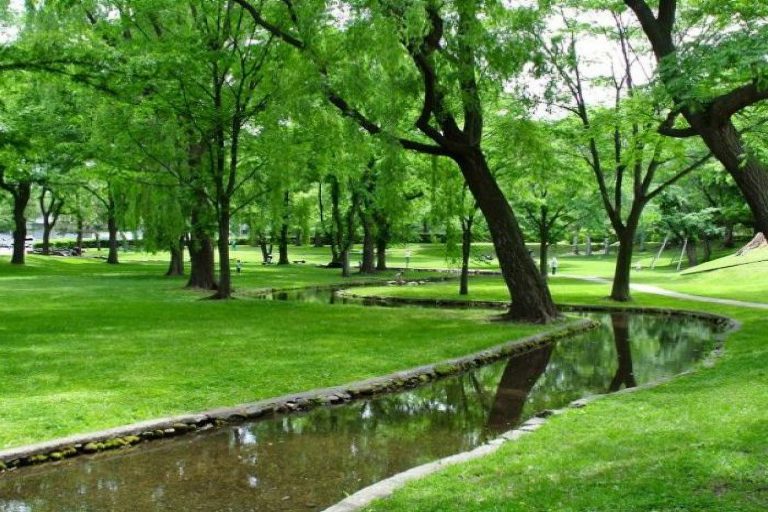Hokkaido University’s lush green campus is nestled in the heart of Sapporo – a city with more than 1.9 million residents. Despite its location directly in front of Sapporo Station, it maintains the feel of Hokkaido’s pristine, unspoiled natural environment with its green urban oasis. A clear stream known as the Sakushukotoni River flows idyllically among the trees and over vast expanses of Central Lawn. It is little wonder the university is often voted as having the most beautiful campus in Japan.
Botanic Garden
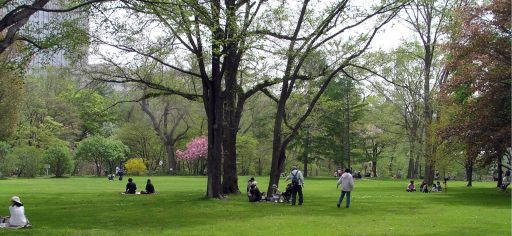
Hokkaido University Botanic Gardens is one of the oldest botanic gardens in Japan, opening in 1886. Located to the south of Sapporo Campus area by a 15-min walk, the garden shows the preserved beauty of pre-urban development Sapporo’s natural landscape—a perfect getaway from the big city. Today, the site is 13.3ha wide and consists mainly of old growth trees showing the original vegetation of Sapporo. Housing around 4,000 kinds of plants including alpine species of Hokkaido and neighboring areas, the Garden also contains historical facilities such as museums and the Miyabe Kingo Memorial Building.
Exhibiting stuffed animals and other archeological specimens from Hokkaido, the green wooden structure located in the middle of the Garden is a designated Important Cultural Property. Here, visitors can also find the stuffed body of the famous ‘Taro’, one of two sled dogs (alongside Jiro) that survived Japan’s first ever mission to Antarctica in 1958. In the Northern Peoples Museum, visitors can find valuable Ainu artifacts.
The gardens are proudly owned and operated by Hokkaido University’s Field Science Center for the Northern Biosphere and have become one of Sapporo’s most popular retreats. Whilst students are a common sight within the gardens, the public are also welcome to discover the beauty of this old and treasured place.
Visitor Information
Botanic garden is open from April 29 to Nov.3 for summer season (see below for details) and closed for winter season.
Summer Season
| Term | Opening Hours | Note |
|---|---|---|
| April 29- Sept. 30 | 9:00-16:30 | (entrance until 16:00) |
| October 1 – Nov. 3 | 9:00 -16:00 | (entrance until 15:30) |
Summer season days closed: Mondays (except if Monday is a holiday, the next day)
Depending on the weather, other days may also be closed. Check before you come!
Admission Fees
Admission is free for students, and University staff. You must show your ID.
| Fees for non-University affiliated persons | Individual | Group (30 or more persons) |
|---|---|---|
| Adults (high school students and above) | 420 yen | 350 yen |
| Minors (grade school and junior high school) | 300 yen | 240 yen |
| Free admittance day: Greenery Day/Midori no hi (May 4) | ||
| Category | Adults (high school students and above) | Minors (grade school and junior high school) |
|---|---|---|
| Multiple admittance tickets (6) | 2,220 yen | 1,620 yen |
Central Lawn
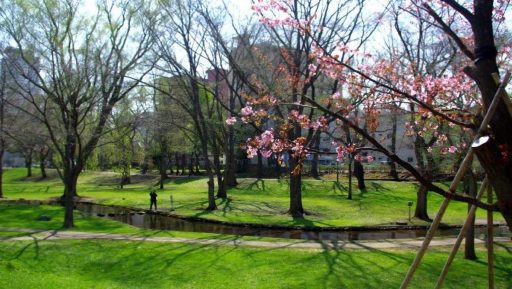
If you enter the Main Gate and walk straight with the southern gate on your left, you will see a gently sloped green area around you. This 12,000-m2 area is known as the Central Lawn. The contrast of light and shade among the trees accentuates the soft green grass in summer. While the rivelut currently running through the central lawn is an artificial one with a concrete base and a flow generated by a pump, there used to be a natural stream here known as the Sakushukotoni River. The old river had its source in the spring near the north side of the Hokkaido University Botanical Garden, and ran through the area east of the Clark Memorial Student Center, Central Lawn, and then the areas west of the Centennial Hall, south of Ono Pond and northwest of the university before joining the Kotoni River. Old master plans from circa 1909, show Chuo Lawn was used as a skating rink, and we also know that salmon were swimming up the river up until the 1940’s.
According to an article in Elm published by Kenzo Iwasawa, Hans Koller, who was posted as a German teacher of a preparatory course at Hokkaido University in July 1908, gave ski lessons to students on one of the snowy slopes. It was thought to be one or two years earlier than the time when Theodor Edler von Lerch gave ski lessons to Japanese military officers in Takada, Niigata, in 1911, which is thought to be the origin of skiing in Japan. If this is indeed the case, it would make the Central Lawn the birthplace of skiing in Japan.
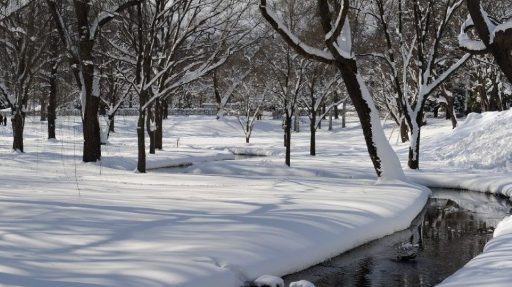
On the northwest corner of the Central Lawn is the bust of William S. Clark, another symbol of Hokkaido University. The first version of the statue was created by the sculptor Sekiro Tajima in 1926 as part of the 50th anniversary of the university’s foundation, with contributions from within and outside the university. Dr. Clark’s famous phrase, “Boys be Ambitious,” was inscribed on its base. A design of the gigantic water lily from the Amazon, Victoria regia, which motivated Dr. Clark to be a botanist/agriculturist, was also on the base at the suggestion of Kingo Miyabe, who designed and became the first director of the Hokkaido University Botanical Garden. However, the first statue was melted down in 1943 under the Metal Recovery Act during World War II. The current statue was recast by the sculptor Kensei Kato in 1948. Although Mr. Tajima had already passed away, the original cast was fortunately stored in the Sapporo Dokuritsu Church. The unveiling ceremony was held on October 8th, 1948.
Elm Forest
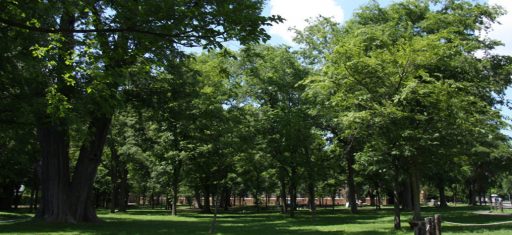
The Elm Forest is a spacious grassy space between the buildings of the School of Agriculture and the School of Science. As its name suggests, the lawn has many elm trees. In the hotter months during the daytime, the trees block out the hot sun, and students can be seen feeling comfortably. The forest reflects the long history of Hokkaido University, its trees in perfect harmony with historic buildings from the days of Sapporo Agricultural College and Hokkaido Imperial University. Tourists visiting this expansive area can get a sense of how distinct the campus and its environment really are.
Ono Pond
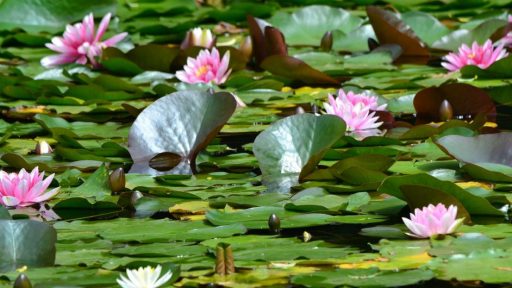
The pond commonly known as Ono Pond is located between the School of Engineering and the Open Innovation Hub “ENREISO” on the west side of the central street. Since its establishment in August 2008 as a part of the Eco-Campus Promotion Project, it has attracted visitors interested in exploring the natural environment of the campus.
In March, when snow still remains, the pond is like a tranquil ink painting. When spring comes, various trees and plants typical of Hokkaido come to life around the pond. Wild ducks lured by brightly colored fish rest their wings in the water by the fountain at the back of the pond. On the shore, there are beautiful white trillium, as well as red and white lotus flowers in the summer, and in the autumn the colored leaves sooth the hearts of visitors. There used to be a river here called Sakushukotoni. This clear stream, with its source on the northern side of the Botanical Garden, ran southeast to northwest through the current campus and joined the Kotoni River. The Ono Pond played a valuable role as one of the springs of the river. Today, vestiges of the river can be seen in the creek flowing through the Central Lawn and the channel on the south side of the pond.
Around 1921, after the foundation of Hokkaido University, the area around the Ono Pond was used as a cattle drive site for the Faculty of Agriculture. The pond supplied drinking water for cows and horses on the farm and the Model Barn. In the Showa era (1925 – 1989), research facilities for the School of Engineering and other departments were constructed around the pond. The 1950s and 1960s were a difficult era for the pond as the surrounding area became more like a dumpsite. In the 1970s, Professor Kazuo Ono of the School of Engineering took on the challenge of restoring the devastated pond to its original state. The pond was gradually restored thanks to the professor’s effort, and eventually came to be known as the Ono Pond. Especially in the summer, the pond is now a popular rest area for students, staff, and visitors who want to enjoy the tranquil environment or use it as a lunch time spot.
Poplar Avenue – Old and New
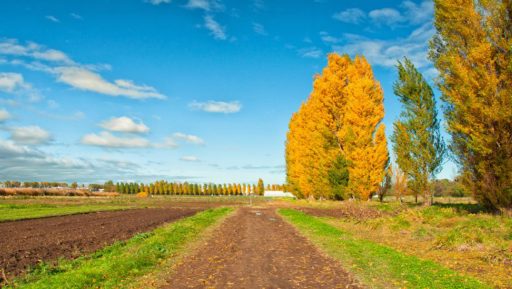
Since when has Poplar Avenue been a symbol of Hokkaido University?
Poplar Avenue runs approximately 250 m alongside the farm on the northwestern side of the School of Science. It appears in most Hokkaido travel guidebooks and attracts an endless stream of tourists between spring and autumn. The poplar (official name is Lombardy poplar) was introduced to Hokkaido in the mid-Meiji era when its seeds were imported from the United States for windbreak forests. The first line of poplar trees at Hokkaido University was planted in 1903. However, it could not be called an avenue until 1912, when 45 trees were planted by students of the School of Forestry. The current avenue of 51 poplars was completed via supplementary planting after some trees fell during a typhoon in 1959. Unfortunately, public access to Poplar Avenue has been forbidden since 1970 due to the possible danger of the collapse/falling of the aged trees. According to the Hokudai Rekishi Sanpo, a walking history of Hokkaido University, the lifespan of poplars is between 60 to 70 years. Although the trees of the Poplar Avenue look young, they are actually withered and old.
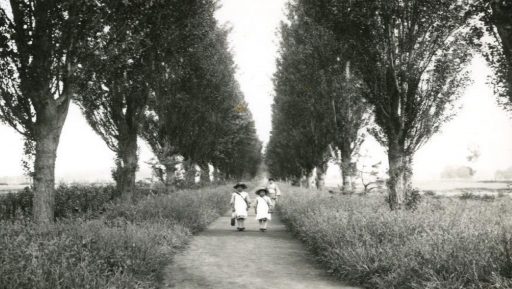
The Heisei Poplar Avenue was created recently as a new symbol of Hokkaido University in place of the old one. The planting ceremony was held in October 2000 as a part of the 125th anniversary of the university’s foundation. The new Poplar Avenue is located 500 m north of the old one on the other side of the farm. A variety of conditions were considered when selecting the location. First, since poplars grow to be fairly large, the avenue needed to be placed in an expansive and flat rural area. Another one of the requirements was that the area must allow pedestrians and cars to pass through the avenue. It also needed to command a view of Mt. Teine. This last requirements originates from the lyrics of the dormitory song Miyakozo Yayoi (“Twilight on the Ridge of Teine”). A part of the song narrates the line of sight extending from the avenue.
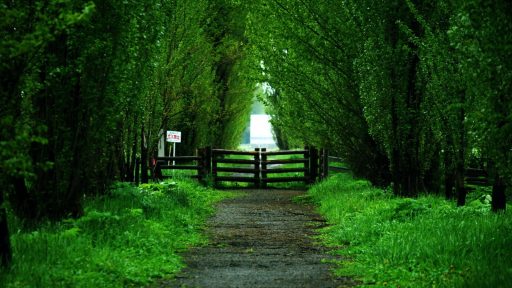
Seventy poplars were planted not too long ago with consideration given to other existing trees in the area. Including these trees, the new avenue is planned to be approximately 300 m long and 16 m wide. The young trees were grown from cuttings collected from the old Poplar Avenue in the nursery garden of the Faculty of Agriculture’s experimental forest. In other words, they are “clone” poplars with the same genes as their parents. In addition to affiliates of the university, citizens participated in the planting of these trees. Everyone contributed to the new symbol of Hokkaido University. These tall, majestic poplars should welcome us in approximately 20 years.
Sapporo Agricultural College Model Dairy Farm
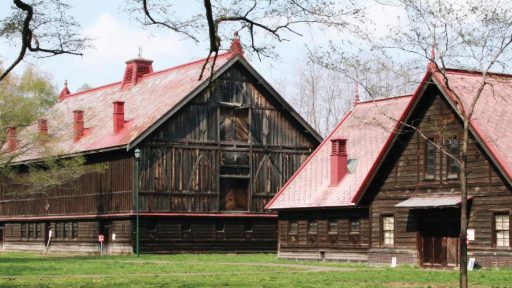
The Sapporo Agricultural College Model Dairy Farm, commonly known as the Model Barn, can be seen on the right if you walk about 500 m west from the Kita 18-jo Station on the Namboku subway line.
The Model Barn, which was designed to resemble a livestock farmhouse and constructed as Hokkaido’s first practice farm for livestock management, has been preserved here along with other related facilities constructed between 1877 and 1911. As balloon framed Western-style buildings were rare in those days and the barn is considered to be the birthplace of Japan’s livestock farming, it was designated as a national cultural asset in 1969.
In addition to the buildings which were added in 1910 when the first ones were moved to their current location, there are about ten buildings surrounding the Model Barn, including those constructed in the early Meiji era (1868 – 1912) in the area between the current university administration office and the building of the Graduate School of Environmental Science. It was used as a university farm until 1969. After that, these buildings were preserved and renovated by the Agency for Cultural Affairs.They are currently used as exhibition facilities containing valuable materials for the history of agricultural technologies, including hundreds of farm tools donated from the early Meiji era.
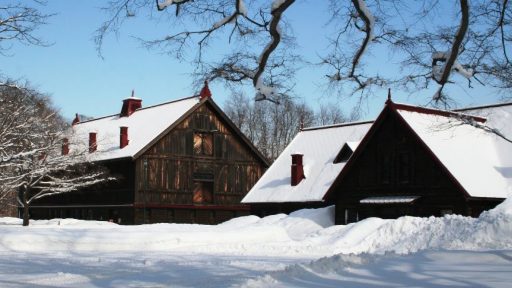
The name “Model Barn” comes from Dr. Clark. He referred to it as a model barn in the hope that it would be a model facility for Hokkaido’s agriculture. It was modeled after a barn at Massachusetts Agricultural College and completed in 1877, and is the oldest and most symbolic building in the Sapporo Agricultural College Model Dairy Farm. The term “model barn” is now commonly used to refer to the entire group of buildings. The large, two-story wooden building, which has a total floor space of 555 m2, has cattle and horse sheds on the first floor and a hay storage area on the second floor. There is a sculpture of a cow’s head immediately above the rail of its exterior wall.
The second most characteristic building is the pasturing cattle shed constructed using the latest technology of its time in 1909. The serene building, which looks symmetrical from the front and has a silo on its east side, has been used as a subject for drawings and photos by many people over the years. This silo, built using Sapporo freestone, has an inner diameter of 5 m and was the largest silo of its kind in the days when it was built. It is said to be the second oldest silo currently existing in Japan, after the one at Koiwai Farm in Morioka. It was also the only building at the Modal Barn where a lightning rod was installed at the time of its construction.
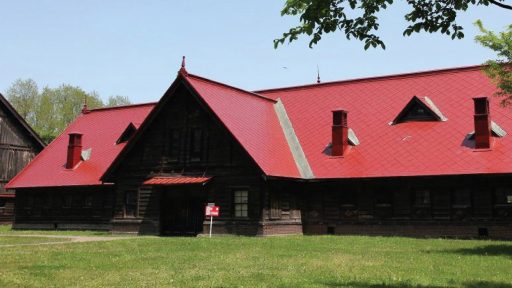
The Farm contains more than 100 Western-style animal-drawn farm tools tested by the Nokoen Farm, including more than ten brought in the summer of 1871 by Horace Capron, United States Commissioner of Agriculture, who was known as the father of Hokkaido’s development. There are also more than 200 tools produced to establish Hokkaido’s own farming methods, based on those tested by the Nokoen Farm.
Entry of visitors into the premises is allowed between 8:30 a.m. and 5:00 p.m.

